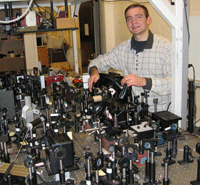Eric Tkacyk receives Best Paper Award for research in biomedical optics
Tkaczyk hopes that his technique will be used to further the understanding, diagnosis, and treatment of cancer. Congratulations!

 Enlarge
Enlarge
Eric Tkaczyk, PhD student in Optics and U-M Medical Student, received the Best Student Paper Award at the Biomedical Optics Symposium (BiOS) of the 2006 Photonics West Conference.
The paper, Increasing two-photon fluorescence signals by coherent control, was co-authored by Eric R. Tkaczyk, Augustin Mignot, Jing Yong Ye, Istvan Majoros, Dr. James R. Baker, and Theodore B. Norris.
Tkaczyk described the research as follows:
“Multiphoton fluorescence is widely used for biomedical microscopy, in vivo sensing, and more recently, non-invasive blood measurements with our newly-developed in vivo flow cytometer. Current detection in these techniques relies on differences in emission spectra (color) of the molecules. However, it is difficult to distinguish important chemicals which happen to be spectrally similar (e.g. blood vs. a circulating cancer stem cell tagged with a red dye). This is a major limitation to potential clinical applications, such as stem cell and cancer research. With what is known as “coherent control,” we may potentially overcome this limitation by shaping the laser pulse to match quantum energy landscape differences in the molecules. This is accomplished by adjusting the arrival time of different frequencies of an ultrashort laser pulse to optimally excite certain molecules and suppress others, despite similarity in color. Using an adaptive computer algorithm, we were able to coherently control the two-photon fluorescent signal of various biologically important dyes.”
Tkaczyk hopes that this technique will be used to further the understanding, diagnosis, and treatment of cancer, and will find use in other biomedical applications.
The BiOS Symposium is the premier annual international forum for discussions and announcements of technical/clinical and educational/pedagogical developments in the use of lasers, optical fibers, spectroscopic diagnostic techniques and related areas of optical medicine. This year’s conference was very well attended, with over 16,000 registered delegates, and more than 1,000 exhibitors. It is an international conference that draws attendees from all over the world.


 MENU
MENU